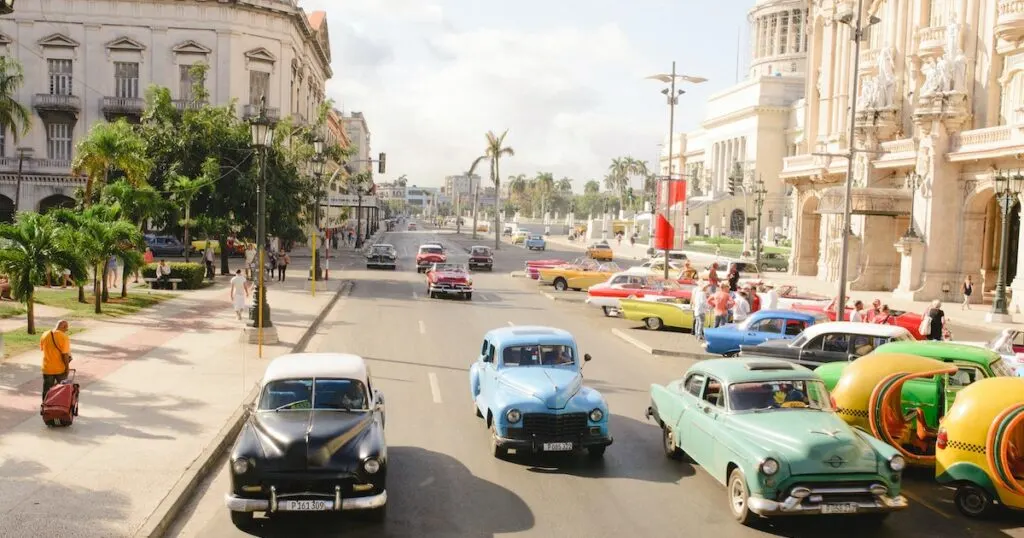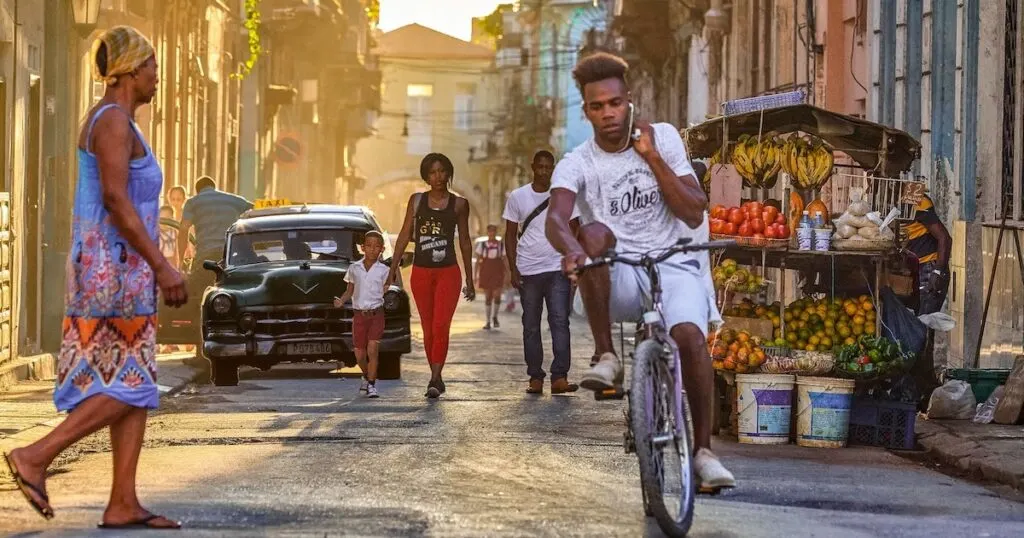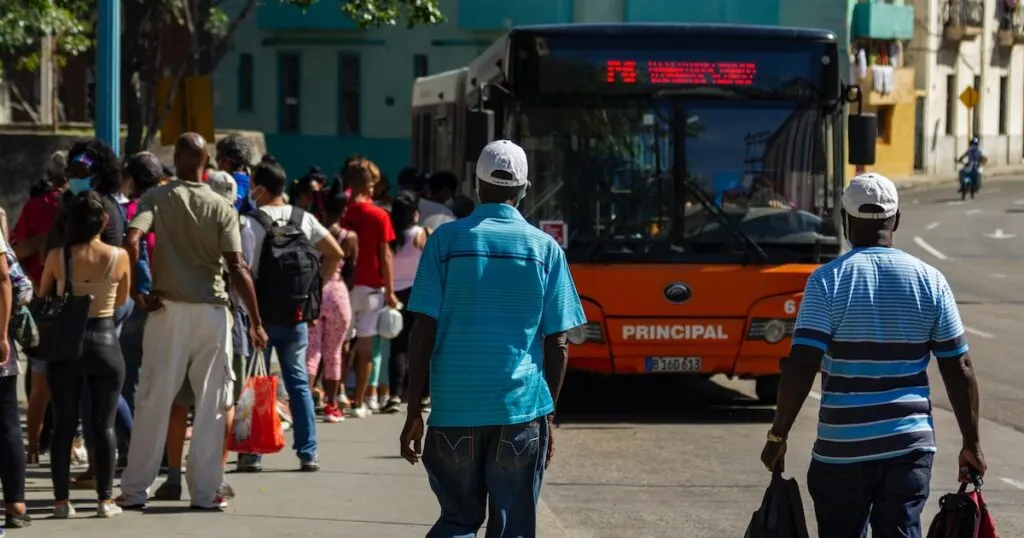Getting around Cuba has many layers. It’s not quite as straightforward as other activities in Cuba, such as sipping on rum on a terrace in Trinidad or bathing in fresh jungle waterfalls. Not to worry: I’ve figured out the best way to travel in Cuba using its unique transportation system.
Bus travel and train travel are both possible in Cuba, but they come with a set of challenges. I’ve ranked the main forms of transportation in Cuba and explained the costs, challenges, and routes involved.
The main thing you need to know about getting around Cuba is that the more flexible you are with your dates and timings, the better. Breakdowns, cancellations, and rescheduled journeys are a matter of course.
ESCAPE CHEAT SHEET
Planning your big escape? These are the booking resources I return to time and time again.
Book your hotel or hostel on Booking.com or Hostelworld.
Protect against accidents and emergencies with insurance from Staysure or SafetyWing.
Find a tour or experience on Get Your Guide.
Travel the world for free with TrustedHousesitters.
Getting Around Cuba: Options for Transportation in Cuba

Many people who visit Cuba land in Havana or Varadero and immediately feel overwhelmed by the complexity of the Cuban transport system.
In fact, many travellers decide to avoid travelling to other destinations in Cuba completely due to a fear of getting stuck in one destination or over-paying for transport. I met several.
To do this, however, would mean missing out on exploring Cuba’s national parks, smaller-town life, and many of the spectacular cities and beaches in the south.
How else will you explore the national park of Topes de Collantes Cuba and swim in the Parque Guanayara Waterfalls?


1. Bus travel in Cuba
When I visited Cuba in January 2022, the bus company Viazul had ceased its services for tourists due to the pandemic. However, as of 2023, the Viazul bus company has been re-established, and now runs buses between major tourist routes (and the airport) in Cuba such as Havana, Varadero, Viñales, Matanzas, Cienfuegos, and Trinidad (depending upon availability). You may hear the bus referred to as an omnibus by locals.
The Viazul website posts up-to-date timetables of their routes and timings. You can book tickets online prior to your departure using their website, or use a VPN to book your tickets while in Cuba (this gives the website the impression that you are booking from abroad). Booking in advance is recommended. You will need to create an account and add your passport details and personal details to book a ticket online.
Viazul allocates a specific amount of online and in-person tickets. If the online allocation has sold out, you can buy a ticket in-person at their office in your destination. If you have internet, you can search for the office on Google Maps or Maps.Me (I found Maps.Me, in general, to be more accurate in Cuba).
If not, your accommodation provider should know the location of the office and give you directions. You should go to the office at least the day before your desired travel date to buy the ticket. You will need to take your passport and cash to book the ticket. Google Translate may be helpful to communicate.
Viazul buses are typically air-conditioned and have reclining seats. According to reviews, they are comfortable. However, the buses usually end up costing the same as a collectivo taxi, which is a quicker and more comfortable form of transport. Travelling to the bus station twice is also time-consuming, whereas collectivo taxis can be booked through your accommodation.

You must travel by bus or taxi to reach Trinidad. See the best things to do in Trinidad Cuba.
2. Private taxi in Cuba

Taxis are readily available in Cuba. While they are the most comfortable and quickest way of travelling around Cuba, they are also the most expensive.
Asking your accommodation to book or order a taxi is the safest way to find a vehicle. They should be able to arrange a good price for you by calling around private taxi companies.
If you are organising your own taxi on the street, you should ask to see the taxi’s license. Police monitor the motorways in Cuba to identify unlicensed numbered plates carrying tourists, and you could be fined if you’re found in this situation.
There are two types of licensed taxis:
State-owned taxis: State-owned taxis are usually yellow Geely or Ladas cars with air conditioning. They are often more expensive than private taxis.
Private taxis: Private taxis are owned by private taxi companies. While they don’t have air conditioning, they are usually more budget-friendly than state-owned taxis. To book a private taxi in Cuba, you should ask your accommodation to call a private taxi company and request a car.
3. Collectivo taxi
Collectivo taxis are the same as a normal private taxi, except the taxi is shared with other tourists who are travelling to the same destination on the same day. The taxi takes turns to collect tourists from their respective accommodations and when they arrive at the end destination, they drop each group directly at their new address one by one.
It is quick, comfortable, and convenient. There’s also usually only a small difference in the price between a collectivo taxi and using the Viazul bus service. Therefore, if a collectivo taxi is running, it is the best budget-friendly option to travel around Cuba.
To arrange a collectivo taxi, you should tell your accommodation your planned destination and departure date. They will call around local private taxi companies to enquire about collectivo taxis that closely meet your requirements and feed back the price and details to you.

Since collectivo taxis run according to demand (and they often stop running on Sundays), you should try to be as flexible as possible around your timings and dates of travel. You should also note that collectivo taxis are trickier to book in low season (from March to October) and along routes that aren’t well-trodden by tourists.
4. Train travel in Cuba
Cuba has a huge train network. In fact, it’s the only country in the Caribbean where the railway line stretches all the way across the island. However, travelling by train isn’t a viable mode of transport for tourists in Cuba. Even Cubans avoid taking the train if they can help it.
This is because there’s such a high rate of breakdowns and cancellations, as well as train timetables that change at very short notice. The conditions inside trains in Cuba are also poor in terms of comfort.
If you’re looking for a reliable and comfortable mode of transport, you should look at booking a taxi or a bus. However, if travelling Cuba by train sounds like a bucket-list thrill you could get behind, be sure to pack toilet paper and view the list of train departures at the train station before your departure.
Tickets can be purchased at the station by showing your passport at the Lista de Espera office and paying by cash or card. The main line that runs through Havana visits Santiago de Cuba, Santa Clara, and Camagüey.
5. Boats
Aside from boat trips or excursions that are available from coastal locations around Cuba, there are only two ferry services in Cuba in 2022. The first operates in Habana Vieja and takes passengers to Casablanca and Regla. It usually departs every 20 minutes or so. Tickets are generally very affordable and paid for in Cuban pesos.
A second ferry service runs between Surgidero de Batabanó and Nueva Gerona on the Isla de la Juventud, leaving three times per week. To get to this island destination, you need to book a combined bus and ferry ticket at the Empresa Viamar desk in Havana’s bus station. The ferry services are prone to cancellations when there are bad weather conditions, which is most common between June and November.
Getting around Cuba: Inter-city transport in Cuba

Once you’ve sorted your transport to and from different destinations around Cuba, you need to work out how to travel within the city or town itself. While it’s easy to explore smaller destinations on foot, cities or rural areas will require an alternative form of transport.
1. Taxis
There are several types of taxis that will get you around cities and towns in Cuba. You should always decide a fare with the driver before boarding the taxi.
Licensed taxis: Yellow state-owned taxis are often parked in bays around busy tourist areas. They are the most expensive taxi option, but they are a comfortable way to ride around. Slightly cheaper private taxis can be ordered through your accommodation. Always check your taxi for a license before getting in.
Bici-taxis: Bici-taxis are made up of a bicycle and a two-seat wagon. Naturally, they are a slower way to travel, so they are best suited to shorter journeys. On the plus side, you can often agree a cheaper fare, and they provide a clear view of your surroundings (and wind in your hair, which is another selling point for me).
Trencito: Trencito are small, train-like trailers that shuttle tourists around destinations such as Havana, Cienfuegos, and Varadero. They are typically quite budget-friendly. Trencito stops are common down malecón stretches in the cities (the main road that runs alongside the sea).
2. Hop-on, hop-off buses
Hop-on, hop-off buses operate in popular tourist cities in Cuba such as Havana, Varadero and Santiago de Cuba. They connect many of the top tourist sights. In Havana, the hop-on, hop-off bus also has a route that visits the beaches near Havana, which are located around 15 kilometres from the city. Although they are usually paid for in cash in euros, they may sometimes require a card payment. Tickets are relatively inexpensive; most journeys cost five euros or under.
3. Bicycle rental
Bicycle rental is another option for getting around cities, towns, and rural areas. It’s a relatively safe way to get around, considering that all Cuban roads have at least one metre of space dedicated to bicycles. There are poncheros (puncture repair shops) along motorways and other rural roads. You should be prepared to cycle without a helmet, because it’s uncommon for a helmet to be offered as part of your bicycle rental.
It generally costs between 70 and 300 Cuban pesos per day to rent a bicycle in Cuba. You should ask your accommodation for directions to the nearest bicycle shop and go from there.
Tips for bicycle rental in Cuba
- Avoid cycling at night because road lighting is poor in Cuba.
- Stick to the bicycle lane, even if it isn’t specifically marked out.
- Park your bicycle in ‘parqueos’, parking spaces reserved for bicycles outside of supermarkets, bus stations, beaches, and tourist sites. They usually cost around 70 Cuban pesos.
- Take sufficient water if you are cycling long distances.
4. Local buses

Since local bus stops often lack any helpful information, it can be tricky to navigate the local bus system as a first-time visitor to Cuba. The buses can also get pretty crowded during peak times, making it seem even more overwhelming.
However, if you have plenty of change to meet the exact bus ticket fee requested (which is usually only a handful of Cuban pesos), this is a cheap way to travel around a city. Naturally, the whole process will be easier if you speak Spanish and can communicate with the bus driver or locals regarding the bus fare and stops.
When you arrive at the bus stop, you should always ask ‘¿Ultima persona para la 232?’ to locate the last person in the queue. Skipping the queue is considered very rude in Cuba.
5. Classic car tours
If you want to cover plenty of ground in one hour, classic car tours can be arranged directly with drivers or agencies in destinations such as Havana and Varadero. In technical terms, they are private taxis in the form of an American, Russian, or Eastern European classic car that was brought to Cuba between the 1930s and 1950s, before the Cuban revolution. Common classic car models in Cuba include Chevrolets, Chryslers and Buicks.
This is more of a tourist activity than a typical mode of transport, so arranging a ride is more expensive than riding in a normal taxi. If you choose to haggle a classic car ride in Havana, it could cost you anywhere between 800 and 2000 Cuban pesos per ride, depending upon your haggling skills and the number of people in your group.
Travel insurance is essential for any trip abroad. If you’re in an accident or experience an emergency, you need adequate cover. I recommend Staysure for single or multiple trips per year and SafetyWing for digital nomads.
Getting around Cuba: How much should a taxi cost in Cuba?
It’s likely you’ll be travelling between some destinations in Cuba by either collectivo taxi or normal taxi. Fares for government-owned taxis typically start at 20-25 CUP per kilometre. The cost of a taxi will be cheaper if you are travelling in a private taxi or a private collectivo taxi.
The following can be used as guide prices:
Cost for a taxi from Havana airport to Havana: 20-25 euros.
Cost for a taxi from Havana to Trinidad: 25-50 euros
Cost for a taxi from Havana to Varadero: 20-40 euros.Renting a car in Cuba
Renting a car in Cuba gives you more freedom to travel when and where you want to. As long as you’re ready to navigate roads with potholes, train tracks, and steep gradients, you’ll be free to explore less-visited beaches and towns around the country.
Getting around Cuba: Renting a car in Cuba
Renting a car in Cuba gives you more freedom to travel when and where you want to. As long as you’re ready to navigate roads with potholes, train tracks, and steep gradients, you’ll be free to explore less-visited beaches and towns around the country.

With a rental car, it’s easy to visit the best beaches Havana – they’re also accessible by hop-on and hop-off bus.
Nevertheless, renting a car in Cuba can be a complicated process and there are some tips for the road that you’ll need to be aware of.
Is renting a car in Cuba worth it?
Before you decide to rent a car in Cuba, you need to know exactly what you’re getting yourself into. There are a few pros and cons to car rental in Cuba:
Pros:
- You have more freedom to explore less-visited parts of Cuba.
- Travel exactly when you want to and where you want to.
- Cuba is mostly traffic free, meaning that journey times by car are usually reasonable.
Cons:
- Driving in Cuba can be dangerous due to poor road conditions, unclear traffic signs, and animals on the roads.
- Driving at night should be avoided due to poor road lighting and poor signage.
- You will need to navigate yourself using a physical map or by using offline maps downloaded on apps such as Google Maps.
- If you get into an accident, the Cuban authorities may ban you from leaving Cuba until the investigation has been concluded.
- Petrol stations are rare outside of the cities and bigger towns, especially on the motorways.
- Gas shortages are fairly common in Cuba.
- Car rental can have hidden fees.
If you’re not planning on travelling extensively around Cuba and most of the destinations you’re going to be visiting are on well-trodden tourist routes, travelling by collectivo taxi or a traditional taxi is a simpler option. If your planned route is more remote, car rental might be worth it, as long as you’re properly prepared and follow the advice below.
How much does it cost to rent a car in Cuba?
The cost of car rental in Cuba depends upon a number of factors, including the demand at the time, the company, car model, any drop-off arrangements, and the number of drivers needed for the car. Typically, the price for renting a car in Cuba is between 30 and 100 euros per day. You may have to pay extra for insurance and liability waivers.
How to rent a car in Cuba
During high season for tourists, which is between November and February, renting a car in Cuba can be tricky due to the high demand for car rental and the limited number of cars in the country. Booking your car months in advance through online travel agencies can increase your chances at securing a rental car in Cuba.
Overall, renting a car in Cuba is a complicated process, which is why you should really evaluate whether it is necessary for your trip.
There are two main ways to rent a car in Cuba:
1. Rent a car through a travel agency.
If you want the security of booking a car in advance, the only option is to use a travel agency. This is because rental companies in Cuba don’t have any online booking systems (or websites, in some cases). Travel agencies for Cuba have mixed reviews and there may be scam websites littered around the internet, so you should always choose a well-esteemed travel agency such as the Cuba Travel Network.
2. Renting a car when you arrive in Cuba.
If you haven’t booked in advance, it’s possible to rent a car when you arrive in Cuba, depending upon the demand. The best way to do this is to ask your accommodation for directions to the nearest car rental provider and visit the office in person. This is likely to be a complicated and (quite possibly) stressful process. The fees are also likely to be higher than those you would get if you rented a car through a travel agency.
You will need a valid license and passport. Payments for rental cars in Cuba are typically made by credit or debit card. You cannot pay in US dollars or pay using a card that is associated with an American bank.
Tips for renting a car in Cuba
- Stick to the speed limit: generally, this is 80km/h on motorways and 50km/h in cities.
- Avoid driving at night due to the poor lighting and poor road signage.
- Look out for railway tracks on roads, including motorways. Common practice is to slow down, listen for foghorns and look both ways before crossing the tracks.
- Download offline maps before travelling because there is poor signage in Cuba and no internet access on the road.
- Ask your accommodation to connect you to a car keeper, who will watch your car when it’s not in use and make sure that no parts are stolen. They typically cost between five and 10 euros per day.
Getting around Cuba: Can I hitchhike in Cuba?
When you travel down Cuban motorways, it’s not uncommon to see lines of people sticking out their thumbs or waving at passing cars. Many locals use hitchhiking as their primary form of transport. In fact, all private vehicles were once obliged to pick up hitchhikers when there were petrol shortages in Cuba in the 1990s.
The tradition has carried on, although many drivers will request payment in the form of a handful of pesos. However, don’t be tempted to join in with Cuba’s hitchhiking tradition. Tourists are only permitted to travel in a licensed vehicle and can face a fine if they’re caught hitchhiking.
Being prepared is key when visiting Cuba. You should also know the ins and outs of money in Cuba (including what currency to bring) and the dress code in Cuba. My Cuba packing list also details exactly what you should and should not bring into the country.
FAQ
The best way to get around Cuba is by collectivo taxi, which provides a comfortable and fairly budget-friendly mode of transport between well-travelled tourist destinations. The vehicle is shared other tourists going to the same destination.
It is safe to travel around Cuba solo, as long as you take the usual safety precautions and travel in licensed vehicles. Normal or collectivo taxis will pick up and drop you directly from your accommodation, making them the safest mode of transport in Cuba. You should check the condition of the car before boarding and agree a fare beforehand. A good way to meet other tourists is by travelling by collectivo taxi.
Travelling around Cuba can seem tricky. However, with the help of your accommodation, the easiest way to travel around Cuba is by booking a collectivo taxi, which transport several different tourists to the same destination at a pre-arranged time and fare. Normal taxis are also easy to book and reliable.
There are no Ubers in Cuba. Traditional taxi services are common, as are collectivo taxi services, and buses may also run between popular destinations depending upon the demand.

